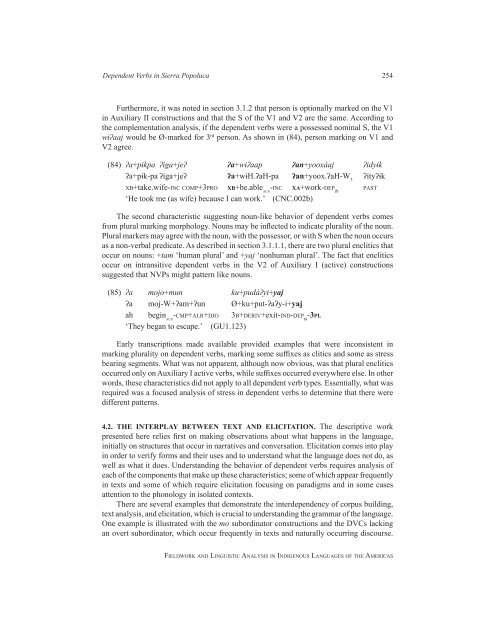Fieldwork and Linguistic Analysis in Indigenous ... - ScholarSpace
Fieldwork and Linguistic Analysis in Indigenous ... - ScholarSpace
Fieldwork and Linguistic Analysis in Indigenous ... - ScholarSpace
Create successful ePaper yourself
Turn your PDF publications into a flip-book with our unique Google optimized e-Paper software.
Dependent Verbs <strong>in</strong> Sierra Popoluca 254<br />
Furthermore, it was noted <strong>in</strong> section 3.1.2 that person is optionally marked on the V1<br />
<strong>in</strong> Auxiliary II constructions <strong>and</strong> that the S of the V1 <strong>and</strong> V2 are the same. Accord<strong>in</strong>g to<br />
the complementation analysis, if the dependent verbs were a possessed nom<strong>in</strong>al S, the V1<br />
wɨʔaaj would be Ø-marked for 3 rd person. As shown <strong>in</strong> (84), person mark<strong>in</strong>g on V1 <strong>and</strong><br />
V2 agree.<br />
(84) ʔa+pɨkpa ʔiga+jeʔ ʔa+wɨʔaap ʔan+yooxáaj ʔidyɨk<br />
ʔa+pɨk-pa ʔiga+jeʔ ʔa+wɨH.ʔaH-pa ʔan+yoox.ʔaH-W 3 ʔityʔɨk<br />
xb+take.wife-<strong>in</strong>c comP+3Pro XB+be.able aux -<strong>in</strong>c XA+work-deP ib Past<br />
‘He took me (as wife) because I can work.’ (CNC.002b)<br />
The second characteristic suggest<strong>in</strong>g noun-like behavior of dependent verbs comes<br />
from plural mark<strong>in</strong>g morphology. Nouns may be <strong>in</strong>flected to <strong>in</strong>dicate plurality of the noun.<br />
Plural markers may agree with the noun, with the possessor, or with S when the noun occurs<br />
as a non-verbal predicate. As described <strong>in</strong> section 3.1.1.1, there are two plural enclitics that<br />
occur on nouns: +tam ‘human plural’ <strong>and</strong> +yaj ‘nonhuman plural’. The fact that enclitics<br />
occur on <strong>in</strong>transitive dependent verbs <strong>in</strong> the V2 of Auxiliary I (active) constructions<br />
suggested that NVPs might pattern like nouns.<br />
(85) ʔa mojo+mun ku+pudáʔyi+yaj<br />
ʔa moj-W+ʔam+ʔun Ø+ku+put-ʔaʔy-i+yaj<br />
ah beg<strong>in</strong> aux -cmP+alr+dJo 3b+deriv+exit-<strong>in</strong>d-deP ia -3PL<br />
‘They began to escape.’ (GU1.123)<br />
Early transcriptions made available provided examples that were <strong>in</strong>consistent <strong>in</strong><br />
mark<strong>in</strong>g plurality on dependent verbs, mark<strong>in</strong>g some suffixes as clitics <strong>and</strong> some as stress<br />
bear<strong>in</strong>g segments. What was not apparent, although now obvious, was that plural enclitics<br />
occurred only on Auxiliary I active verbs, while suffixes occurred everywhere else. In other<br />
words, these characteristics did not apply to all dependent verb types. Essentially, what was<br />
required was a focused analysis of stress <strong>in</strong> dependent verbs to determ<strong>in</strong>e that there were<br />
different patterns.<br />
4.2. THE INTERPLAY BETWEEN TEXT AND ELICITATION. The descriptive work<br />
presented here relies first on mak<strong>in</strong>g observations about what happens <strong>in</strong> the language,<br />
<strong>in</strong>itially on structures that occur <strong>in</strong> narratives <strong>and</strong> conversation. Elicitation comes <strong>in</strong>to play<br />
<strong>in</strong> order to verify forms <strong>and</strong> their uses <strong>and</strong> to underst<strong>and</strong> what the language does not do, as<br />
well as what it does. Underst<strong>and</strong><strong>in</strong>g the behavior of dependent verbs requires analysis of<br />
each of the components that make up these characteristics; some of which appear frequently<br />
<strong>in</strong> texts <strong>and</strong> some of which require elicitation focus<strong>in</strong>g on paradigms <strong>and</strong> <strong>in</strong> some cases<br />
attention to the phonology <strong>in</strong> isolated contexts.<br />
There are several examples that demonstrate the <strong>in</strong>terdependency of corpus build<strong>in</strong>g,<br />
text analysis, <strong>and</strong> elicitation, which is crucial to underst<strong>and</strong><strong>in</strong>g the grammar of the language.<br />
One example is illustrated with the mo subord<strong>in</strong>ator constructions <strong>and</strong> the DVCs lack<strong>in</strong>g<br />
an overt subord<strong>in</strong>ator, which occur frequently <strong>in</strong> texts <strong>and</strong> naturally occurr<strong>in</strong>g discourse.<br />
fieldwork <strong>and</strong> l<strong>in</strong>guistic analysis <strong>in</strong> <strong>in</strong>digenous languages of the americas

















